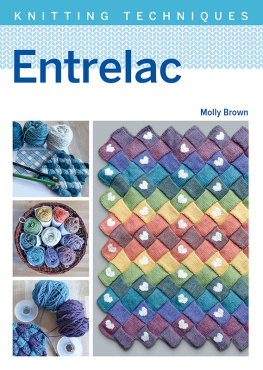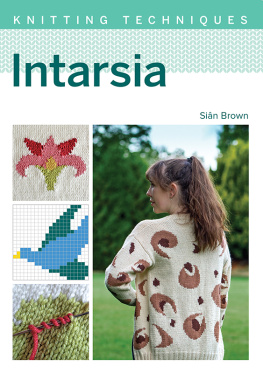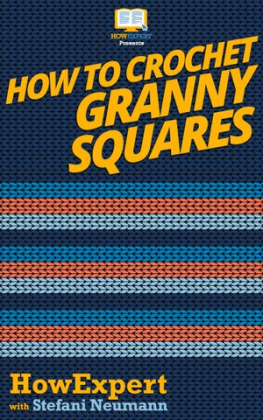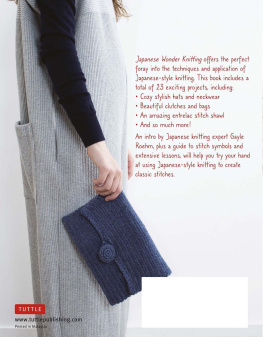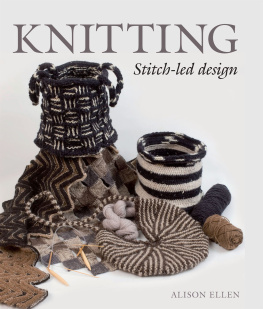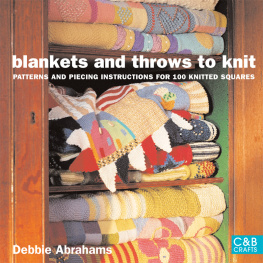Page List

First published in 2022 by
The Crowood Press Ltd
Ramsbury, Marlborough
Wiltshire SN8 2HR
www.crowood.com
This e-book first published in 2022
Molly Brown 2022
All rights reserved. This e-book is copyright material and must not be copied, reproduced, transferred, distributed, leased, licensed or publicly performed or used in any way except as specifically permitted in writing by the publishers, as allowed under the terms and conditions under which it was purchased or as strictly permitted by applicable copyright law. Any unauthorised distribution or use of this text may be a direct infringement of the authors and publishers rights, and those responsible may be liable in law accordingly.
British Library Cataloguing-in-Publication Data
A catalogue record for this book is available from the British Library.
ISBN 978 1 78500 984 6
Cover design: Sergey Tsvetkov
Abbreviations
| CO | cast on |
| k | knit |
| k2tog | knit two stitches together |
| LH | left-hand |
| m1 | make one stitch by picking up and working the loop between the stitches |
| p | purl |
| p2tog | purl two stitches together |
| psso | pass slip stitch over |
| RS | right side of the work |
| RH | right-hand |
| Sl | slip |
| SSK | slip, slip, knit. Slip one stitch knitwise, slip next stitch knitwise, insert LH needle into the front of the two slipped stitches on the RH needle and knit both stitches together |
| W | wrap |
| WS | wrong side of the work |
Introduction
F or many years entrelac had been a technique I knew was there but had not mastered. Some years ago, I mastered the technique and then started to explore the possibilities of this intriguingly textured knitting. I find it very pleasing to knit. As someone who likes to see the progress in my projects, I find working small blocks helps me have a sense of achievement. Even when the time I have to spend on a project is limited, getting even one block completed is usually an achievable goal and therefore satisfying.
Since learning the technique, I have also started to teach it to other people. This has put me in a unique position to write a book on the subject. Not only have I learnt from my own mistakes, but I have also seen the mistakes often made by others. So, I have included in these pages a section about commonly made mistakes and how to avoid them which I hope you will find useful.
Entrelac requires you to master six steps or building blocks. To help you understand the required building blocks, the book begins by looking at the anatomy of entrelac. I explain this so those of you who like to know where they are going can begin to get a handle on how entrelac works before you pick up your needles. But for those of you who just need to knit to learn as you go, skip on to , but do check back to the anatomy if you need to.
Entrelac is a bit like building blocks, all nestling or tessellating neatly with their neighbours. But because of its unique construction, it does not lay flat when it is on the needles. It can therefore be a little tricky to see where you are up to at times. So, to help you get the hang of entrelac, I have taken step-by-step photos of the knitted swatch both on and off the needles. In this way, you can more easily see where you are up to and where the next step fits into the overall structure.
A basic swatch is explained in step-by-step detail in . Some of these variations have then been used in the patterns in Part Two of the book.
In making each small section, the rows are not very long. You soon reach the end of a row and are turning to work the next. Therefore, if you are someone who gets bored on a big project by endless rows of knit or purl, then entrelac might just be the answer for you as each block can be a mini target of achievement in the whole project. Once you get into the flow of entrelac, you will find yourself sitting down intending to complete just one block then, before you know it, you are on your second or third block and the work is growing beautifully.
Being worked over lots of short rows does mean that the work needs to be turned , but in essence it is working the wrong side rows from the right needle to the left, therefore avoiding the need to turn the work. I can thoroughly recommend encouraging your brain to allow you to do this, even though it might mean unlearning many years of habit.
The buzz I get from teaching is seeing how people go on to use the technique I have taught them, rather than them producing an item identical to something I have made. In these pages you will find all the steps you need to master for knitting basic entrelac clearly explained, as well as four lovely patterns for you to follow. However, each pattern also has ideas for variations to the design. With simple tweaks to the patterns, you can stamp your own flair on the basic ideas. You will find suggestions and information about how to do this included in the pages of this book. In the Appendices, at the back of the book, there is an entrelac grid and a page of knitting graph. They are there to help you develop your own ideas.
Have fun!
A HISTORY OF ENTRELAC
Where the technique of entrelac first originated and how it comes to be given this name is not clear. Despite having dug around for information for the purposes of this book, I have not been able to uncover and pinpoint when the word entrelac became associated with the technique. As it doesnt seem to have been in the post-war knitting patterns our mothers or grandmothers used, we are perhaps inclined to think of it as new. Well, it seems that is far from the case.
As a hands-on kind of girl, I dont often prioritize time for looking at textile history, but I am none the less interested in the subject. In 2016, I was lucky enough to make a journey with my husband on our tandem. The journey was from our home in Chester (UK) to Istanbul. On this trip we visited many museums I might even say too many. It was not unusual to find me sitting knitting, while I waited for my husband to complete his tour of the museum we were visiting. The museum that stands out in my memory was in Burgas, Bulgaria, on the Black Sea coast. This lovely little museum was packed with examples of textiles of all kinds. I took as long looking round as my husband did, possibly even longer. However, there was no entrelac, so I digress. But I mention this, as researching the history of entrelac for this book has been fascinating and enjoyable. As you will read, from my computer I have travelled widely in Northern Europe and across to America. I have felt I ought to put on a Sherlock Holmes hat and keep a magnifying glass nearby. It feels like there are strands leading off in different directions. It would be lovely to follow the threads by making trips to these places, to see what more I can find out.

